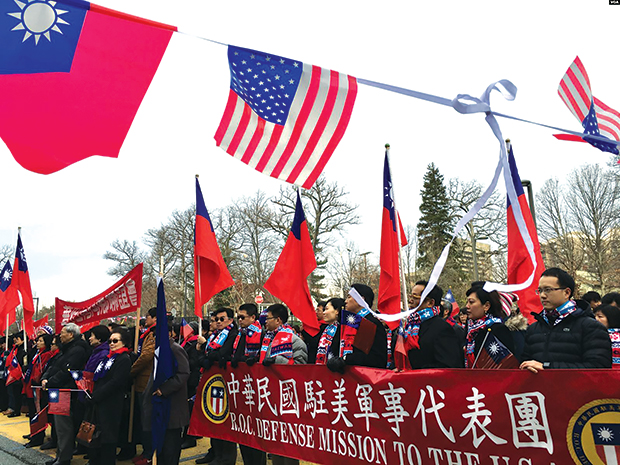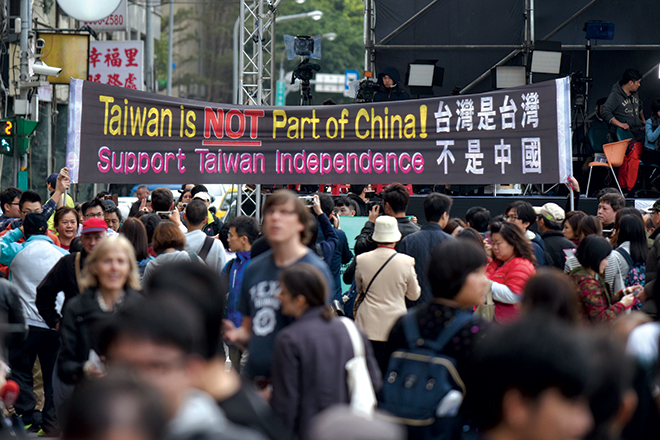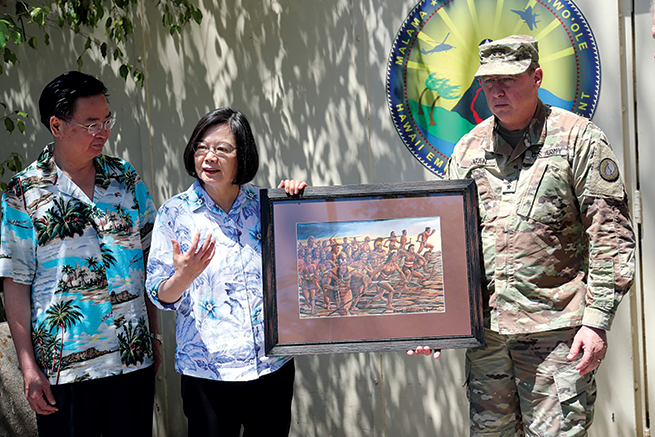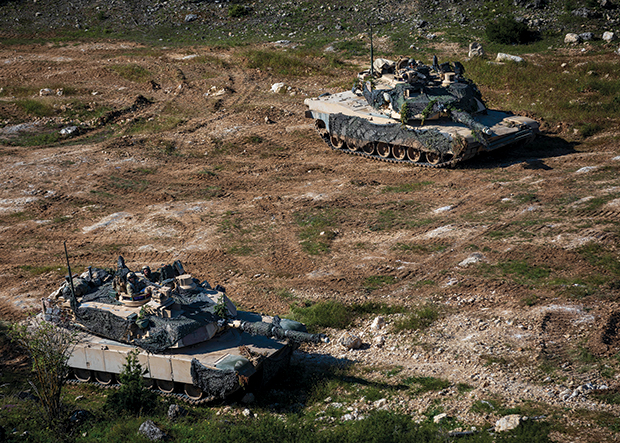
For the first time in decades, the evolving security situation in the Taiwan Strait offers the U.S. Army a chance to play an important role in deterring Chinese military action and strengthening American strategic connections in East Asia. In the western Pacific, the U.S. Army has been traditionally focused on the Korean Peninsula, but a shifting political context, technological developments, and new policies are expanding the U.S. Army’s opportunity to play a larger part in maintaining stability in the region.
A Starker Strategic Context
Over the past five years, the strategic consensus that engagement between the United States and the People’s Republic of China (PRC) would provide long-term benefits and possibly political changes in the PRC has been abandoned by both the Republican and Democratic parties. Opposition to Chinese predatory economic practices, aggressive territorial actions in East Asia, and Communist Party of China General Secretary Xi Jinping’s domestic political crackdown has led to a backlash throughout the U.S. foreign policy community. Then Secretary of Defense James Mattis released the 2018 National Defense Strategy, identifying China as a “strategic competitor using predatory economics to intimidate its neighbors while militarizing features in the South China Sea.”1 Alongside increasing concerns about the PRC, connections between the United States and Taiwan have been steadily expanding. Since the passage of the Taiwan Relations Act in 1979, the United States has been committed to preserving close economic and cultural ties with Taiwan, as well as providing defensive military equipment.2 Although in accordance with the “One China Policy,” the U.S. formally recognizes only the People’s Republic of China, rather than the Republic of China (Taiwan), U.S.-Taiwan government relations have been increasing in the past several years. The Obama administration supported Taiwan’s inclusion in several international organizations, such as the International Civil Aviation Organization.3 On 31 December 2018, President Donald Trump signed the Asia Reassurance Initiative Act, passed by Congress with unanimous consent, which increases support to Asian allies and specifically called for expanded contact with Taiwan through expanded defense sales and high-level visits.4 In November 2019, Heino Klinck, U.S. deputy assistant secretary of defense for East Asia, visited Taiwan; the visit was the highest level American military engagement in a decade.5 The year 2019 also marked the fortieth anniversary of the Taiwan Relations Act, which was commemorated by numerous ceremonies, exhibitions, and speeches in Taipei and Washington.6 In 2020, the United States (together with Japan), also began an effort to increase Taiwan’s role in the World Health Organization, after Taiwan’s deft handling of the COVID-19 pandemic drew international praise.7
The past twenty years has seen an increasingly stark disconnect between Taiwan and China, as a distinctive Taiwanese identity has flourished, while the PRC’s intensely nationalistic posturing has further separated the two distinct societies and cultures. The relationship between Taiwan and China has posed a political challenge since 1949, when Mao Tse-tung’s communist People’s Liberation Army (PLA) forces defeated the Republic of China’s (ROC) military and forced Chiang Kai-shek’s government to flee to Taiwan. Over 80 percent of the modern-day Taiwanese population has no direct familial connection to China, their ancestors having emigrated to Taiwan hundreds or even thousands of years earlier. During the Cold War, the ROC government that had fled to Taiwan in 1949 promoted an official historical narrative of a shared “Chinese” culture on both sides of the Taiwan Strait. Historians and political scientists have increasingly highlighted the shallow roots of this cultural project, with recent scholarship illustrating that Cold War propaganda to “retake the mainland” was a political slogan that was not indicative of larger cultural or social affinities between China and Taiwan.8 Since Taiwan’s democratization in the 1980s and 1990s, the majority of the population has been skeptical of political and social connections to the PRC, and since the year 2000, Taiwan’s Democratic Progressive Party, which is wary of China, has won four out of six ROC presidential elections. Moreover, Taiwanese voters have shown increasingly negative opinions of China during Xi’s rule, and the voters do not desire any political relationship. In 2020, over 83 percent of the voters identified as Taiwanese, compared to the 5 percent who self-identified as Chinese.9 A strong identification with Taiwan, and a negative opinion of China, is especially apparent among younger demographic cohorts, who see China as belligerent and repressive, especially in light of the recent Hong Kong protests.10 Taiwan’s free press, its openness to immigration, and its changing social views (such as the legalization of same-sex marriage) also deepens the psychological divide. In effect, Taiwan’s society and culture has evolved away from any real possibility of a sustained political relationship with China.

The 1st Battalion, 142nd Field Artillery Regiment team fires an Army Tactical Missile System 10 July 2015 at White Sands Missile Range, New Mexico. (Photo by Sgt. Katie Grandori, Arkansas National Guard Public Affairs Office)
In addition to a deep cultural and political divide, Taiwan’s economic relationship with China has also been wavering in the past five years. Since China began allowing Taiwanese investment in 1988, China has become Taiwan’s largest trading partner, accounting for roughly 23 percent of Taiwanese exports in 2018, although this percentage is falling.11 The signing of a tariff lowering Economic Cooperation Framework Agreement between China and Taiwan in 2010 set off massive protests in Taiwan, where many were worried that dependence on the Chinese market would allow for economic coercion and undermine Taiwan’s sovereignty. While trade did increase after Economic Cooperation Framework Agreement was signed, in the past four years Taiwan’s economic investment in China had been declining, and Chinese investment growth in Taiwan has slowed sharply. Taiwan is also seeking to diversify its economic connections, and has negotiated free trade agreements with Singapore, New Zealand, and Panama.12 The U.S.-China trade dispute has also created an opportunity for Taiwan, with Taiwan’s economy growing at a rate of 3.4 percent in the fourth quarter of 2019, as U.S. companies sought to diversify their supply chains and move away from a reliance on China.13 The U.S.-China trade dispute also appears to have boosted U.S.-Taiwan connections, especially in hi-tech industries, with a May 2020 announcement of a massive $12 billion investment by a Taiwanese company in a semi-conductor facility in Arizona, as well as the establishment of a Google research cluster in Taiwan.14
On the other side of the Taiwan Strait, the contrast to Taiwan’s increasingly democratic, postmodern society is stark, as Xi continues to consolidate power and assert Chinese strength on the world stage. Since becoming General Secretary of the Communist Party of China in 2012, Xi has authorized the construction of artificial islands as a means of pursuing aggressive policies in the South China Sea; widespread cyberattacks and massive espionage activities directed toward the United States; and extensive military posturing toward neighboring countries such as Japan.15 At home, Xi has greatly expanded the powers of security agencies, turned the vast western region of Xinjiang into a laboratory of Orwellian surveillance, and conducted widespread detentions of the Uyghur people. Xi has been similarly direct with Taiwan by personally establishing hard-line policies, underscoring that China will take the necessary actions to preserve its territorial claims. In a January 2019 speech regarding Taiwan, Xi stated, “We make no promise to renounce the use of force and reserve the option of taking all necessary means.”16 Xi’s views have further limited the possibilities for a political and diplomatic solution to the cross-straits dispute, and the PRC’s frequent saber rattling through military exercises and fielding advanced weapons has made the balance of military power in the Taiwan Strait increasingly fragile.
The Shifting Conventional Military Balance
While the political and cultural divide between Taiwan and China has widened, the balance of military power has shifted, not just between Taiwan and China but also between China and the United States. Since 1949, Taiwan has maintained a large military for a country with a population of twenty-three million people, using conscription and extensive purchases of U.S. equipment to create a very effective deterrent force. However, the growing capacity of the PLA to use air, naval, and missile forces to threaten Taiwan and which calls into question the forward basing of U.S. forces in East Asia has now forced a fundamental redesign of Taiwan’s defense policy, and U.S. planners are also searching for new operational models to project power.
China’s extensive military force modernization program is designed to provide the PLA with the ability to fight “informatized wars under local conditions,” which means short, high-tech conflicts in China’s periphery and a long-term goal of “world-class” military power in twenty to twenty-five years.17 The PLA naval force is already larger than the U.S. Navy in total number of ships, and multiple aircraft carrier groups are under construction.18 Chinese investment in large shipyard building capacity means that naval vessels can be built rapidly; for example, forty-one Jiangdao-class (type 056) corvettes were built between 2013 and early 2019, and the building boom shows no signs of ending.19 PLA ground forces continue to reduce personnel strength, while increasing formations.20 In 2015, the PLA command structure was also refined to create five theater-level commands, allowing for streamlined joint operations.21 The PRC has become a world leader in hypersonic missiles and the DF-17 ballistic missile, which has a range of 1,500 miles and a speed of Mach 5, is expected to reach initial operating capability in 2020.22 The impact of the Chinese massive spending and growing offensive capability has inspired doubt in the U.S. Navy’s ability to provide security in the western Pacific region.

Taiwan pro-independence supporters display a banner before a Democratic Progressive Party gathering 16 January 2016 in Taipei. Taiwan elected its first female president in the historic vote, ending eight years of closer ties with China. (Photo by Philippe Lopez, Agence France-Presse)
Taiwan’s military has not been passive in the face of rising Chinese military threats and has continued to modernize its forces and adapt defense policies to the changing threats. Taiwan’s ground forces have undergone major changes, with many of the older M41 and M48 tanks put into storage while newer, more mobile systems have been introduced. An eight-wheeled armored vehicle, the CM-32 “Cloud Leopard,” which functions much like the U.S. Army Stryker, has been domestically produced and has multiple configurations including mortar carrier, infantry squad, and command models. To upgrade the survivability and firepower of its armored forces, in 2019, Taiwan purchased over one hundred M1A2 Abrams tanks from the United States.23 Since 2006, Taiwan has worked to create three combat aviation brigades modeled after U.S. formations and purchased sixty UH-60M Blackhawk medium-lift utility helicopters and thirty AH-64D Apache Longbow attack helicopters to join its existing fleet of CH-47 Chinook heavy-lift and UH-1 Huey medium-lift helicopters.24 Taiwan has invested heavily in U.S. Army missile systems, spending billions on Patriot missiles and Army Tactical Missile System for its M270 rocket launch vehicles.25 Taiwan’s F-16 fighter aircraft force is set to receive a major upgrade of its existing F-16A/B fleet to the F-16V configuration; it will also add sixty-six more new F-16 aircraft, an effort costing over $5 billion.26 The effect of these military acquisitions and improved capabilities maintains a tenuous balance in the region and preserves a credible deterrence presence in Taiwan.
The U.S. Army could play a vital role in assisting with the development of new defense strategies in East Asia that could deter People’s Republic of China (PRC) aggression even if Taiwanese and U.S. naval and air forces were unable to defeat PRC attacks offshore.
In contrast to the intensive reform and procurement programs in Taiwan and China, the U.S. Army has not developed or deployed any new equipment or programs of significance in the past fifteen years that directly address the challenges in the western Pacific. This neglect was largely caused by the focus on counterinsurgency operations during the post-9/11 period as well as budget reductions due to sequestration. The Army Futures Command (AFC), created in 2018, was a positive development for the U.S. Army. AFC bears responsibility for a number of efforts that could have a tremendous impact in deterring PRC actions, such as boosting long-range firepower and developing next-generation Army weapons. AFC also examines supporting elements, such as “assured position, navigation and timing” to protect against enemy interference with electronics and a “synthetic training environment,” to provide new training options.27 One bright spot in the near future is the development of the precision strike missile, which can hit ground and naval targets at a range of up to four hundred kilometers and can be mounted in existing U.S. Army High Mobility Artillery Rocket System or Multiple Launch Rocket System launchers, both of which Taiwan also operates.28 The U.S. Army’s recent developments are promising, and Taiwan offers an intriguing location for mutually beneficial coordination because of shared Chinese threats to cyber systems, tactical networks, and the need for long-range precision fires.
New Strategies and Policy Options in East Asia
Although the military balance of power in the western Pacific is currently sufficient to promote stability and maintain peace, Taiwan and the United States will both increasingly need the robust, layered defense that ground forces provide in order to deter PRC military action. The U.S. Army could play a vital role in assisting with the development of new defense strategies in East Asia that could deter PRC aggression even if Taiwanese and U.S. naval and air forces were unable to defeat PRC attacks offshore. The defense situation in East Asia is fluid, and the PRC has continued reforms to its ground forces to emphasize the ability to seize and control disputed land territory and prevent a layered defensive force from challenging PLA operations. This evolving situation presents the U.S. Army with an opportunity to provide support and assistance, as well as refine old techniques for the twenty-first century multi-domain environment.
In the past five years, new ROC defense plans have sought to strengthen land-based defenses and present China with the challenge of overcoming robust and decentralized ground defenses. This strategy, known as the “Overall Defense Concept,” seeks to provide low-cost asymmetric capabilities. For example, in addition to conducting an immediate counterattack on PRC forces at a beach landing site using M1A2 tanks and AH-64 attack helicopters, ground units will prepare a layered defense that will not only inflict high casualties but will also provide time for reinforcements to mobilize from reserves or arrive from overseas.29 Taiwan has begun developing an indigenous High Mobility Artillery Rocket System, which can deploy rapidly and is small enough to maneuver through Taiwan’s dense urban environments or mountainous terrain. Taiwan is also purchasing hundreds of Stinger antiaircraft missiles, as well as over 1,400 Javelin and tube-launched, optically tracked, wire-guided (TOW) antitank missiles to add to the thousands of short-range, portable missiles it already has on hand.30 In addition, Taiwan has developed an indigenous shoulder-fired disposable antitank missile and has begun distributing hundreds of the systems to locations throughout the country.31

Taiwan’s President Tsai Ing-wen (center) meets Maj. Gen. Arthur J. Logan, commander of the Hawaii National Guard, 28 March 2019 during a tour of the Hawaii Emergency Management Agency (Hi-EMA) and the Hawaii National Guard’s disaster prevention center in Honolulu. (Photo courtesy of the Office of the President of the Republic of China [Taiwan])
The Overall Defense Concept is also pushing Taiwan to reshape its large number of reserve forces into a more operational and capable element of a layered defense. During the Cold War and into the 2010s, Taiwan required eight years of military service in the reserves after the period of mandatory conscription, and the overall pool of reserve manpower was over 3.5 million, with 2.5 million having army experience.32 Taiwanese men are now conscripted for only four months of military training rather than a prolonged period of military service.33 Taiwan’s reserve system has never been fully activated in a crisis, and most reservists complete four “refresher” weekend exercises that include rifle marksmanship training, limited combat training, and learning basic disaster relief skills.34 Although changes to Taiwan’s reserve forces are needed to make it more capable and responsive, this force represents an enormous military resource with significant deterrence potential. Due to the PLA downsizing and streamlining into a force of roughly 1.3 million ground force personnel, not all of whom can be deployed, Taiwan has a significant advantage in sheer numbers if it can create a more active, capable reserve element. The U.S. Army can serve as a useful partner in the effort to strengthen Taiwan’s reserve capacity because the United States has developed a complex Army Reserve and National Guard system that supports operational rotational assignments as well as domestic disaster relief functions. Even creating a small operational reserve of roughly one hundred thousand personnel could provide additional brigades and support units during a crisis by reinforcing defenses and augmenting the active duty force.35 Taiwan’s policy makers have already been seeking U.S. Army assistance in creating a more robust and flexible ground component. During President Tsai Ing-wen’s 2019 stopover in Hawaii, she visited the Hawaii Army National Guard Emergency Management Agency to understand how the U.S. National Guard units coordinate with other local and federal agencies.36
The shift toward a layered defense and asymmetric responses has not gone unnoticed in China, which has also been reforming its military forces to provide a larger manpower pool for expeditionary operations and new specialization in combat support roles. During the past five years, the People’s Armed Police (wuzhuang jingcha budui, or PAP), a paramilitary force that serves as an adjunct to the PLA, has undergone a radical transformation. The PAP augments PLA ground forces, providing combat support roles similar to military police in the U.S. Army. The PAP has been systematically reformed from a dumping ground for passed-over officers and retired soldiers into a highly trained and well-equipped reaction force that can deploy to disputed areas. Changes in the PRC command structure have also more closely linked the PAP to military affairs. On 1 January 2018, the PAP was moved under the control of the Central Military Commission and the Central Committee of the Chinese Communist Party, both of which are headed by Xi.37 In order to focus on combat roles, this organizational shift saw the PAP shed many civilian roles such as border protection and safeguarding natural resources. PAP forces have been structured into two “mobile contingents,” each commanded by a two-star general officer.38 These new formations have been equipped with heavier and more advanced weaponry, armored vehicles, helicopters, and unmanned aerial vehicle capabilities. PAP detachments have also been shifting from a stationary duty location to an expeditionary model; PAP units spend a year or two in Tibet or Xinjiang, which are regions with significant animosity to the PRC government, before rotating into a training and recovery phase. In total, these reforms of the PAP have made it a valuable resource of tactics and manpower that can support PLA efforts to defeat a layered defense approach to ground conflict in Taiwan.

Like those Taiwan purchased from the United States, two M1 Abrams main battle tanks with 1st Armored Brigade Combat Team, 1st Infantry Division, search for optimal defensive positions 19 August 2019 during the culminating force-on-force exercise of Combined Resolve XII at the Joint Multinational Readiness Center in Hohenfels, Germany. (Photo by Sgt. Thomas Mort, U.S. Army)
Outlook for the Future and the U.S. Army’s Role
In this dynamic environment between the PRC and ROC, the U.S. Army has an opportunity to become more involved and play a vital role in several ways. Unfortunately, the U.S. Army has not been proactive and is not a leading voice in the Washington policy discussion on Taiwan or the PRC. For example, in the 2018 National Defense Authorization Act, Congress identified several tasks related to engagement, including Taiwan’s participation in “Red Flag” U.S. Air Force exercises and for the U.S. Navy to “conduct bilateral naval exercises, to include pre-sail conferences, in the western Pacific Ocean with the Taiwan navy.”39 No mention was made of a U.S. Army role, which is not surprising due to the lack of U.S. Army messaging in Washington detailing what the service can provide. U.S. Air Force and Navy officers and senior leaders, both active duty and retired, are frequent speakers at Washington think tanks and research centers. In contrast, positions within the Department of Defense that coordinate East Asia policy in general, and PRC or Taiwan policy in particular, are rarely staffed by Army officers.
If the U.S. Army can become more active within Washington, D.C., where U.S. budgets are created and policy debates occur, there are two vital areas with excellent possibilities for future security development in the Taiwan area. First, the Army appears to be making great progress in developing long-range precision fires, and the Taiwan environment would be an excellent area to work through operationalizing the technology and developing new procedures. Second, the U.S. Army has made tremendous improvements in how it has trained and used reserve forces in the past two decades, and there are lessons that can help Taiwan as it attempts to “operationalize” its reserve component. By playing a more proactive role in policy debates, continuing to focus on relevant technologies, and sharing organizational lessons, the U.S. Army can impact an important and potentially dangerous flashpoint in the world today.
No comments:
Post a Comment